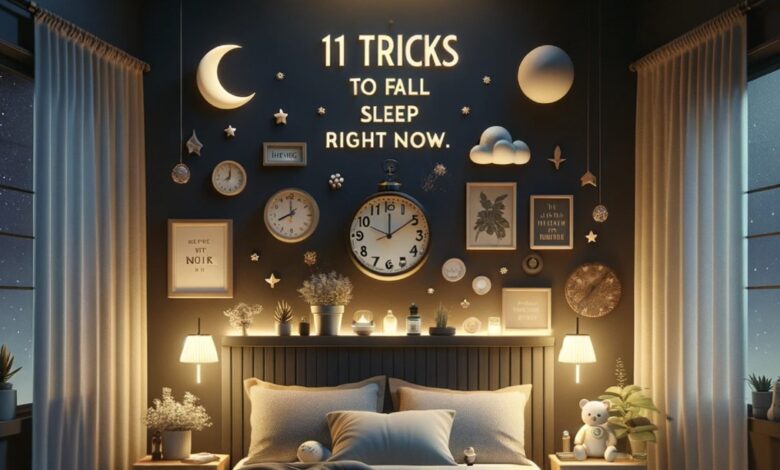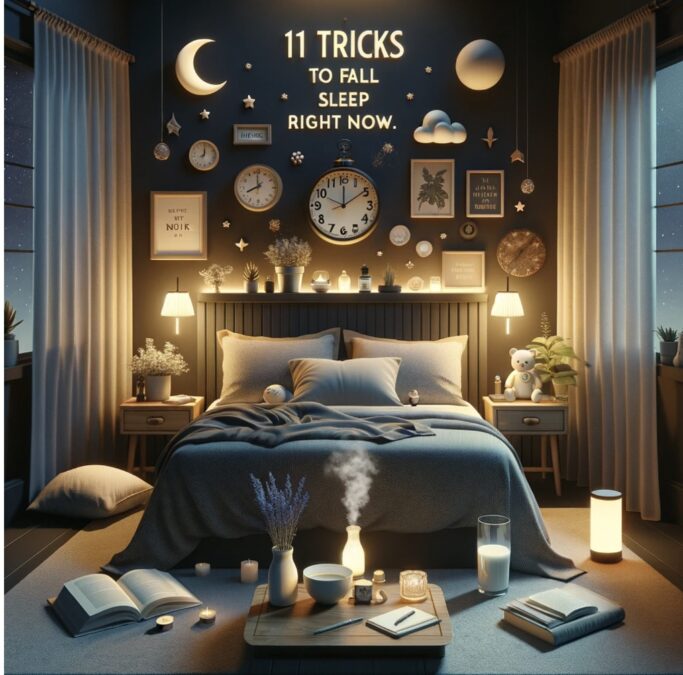11 tricks to fall asleep right now
Share

How to learn to switch off instantly – ideas from neuroscientists and the US military.
No one brags about eating poorly or not exercising enough – but many people brag about their lack of sleep. Just think of Emperor Napoleon, who, according to biographers, slept only 3-4 hours a day, believing that only the most insomniac people could afford to be idle for longer.
Modern scientists radically disagree with his approach. According to the US Centers for Disease Control and Prevention (CDC), average adults need at least 7 hours of sleep a night.
So, most of us know that we need to get more sleep. But what if you can’t fall asleep every night? We’ve studied and tested the work of modern scientists and collected some of the best, scientifically proven, and working techniques for falling asleep quickly. Try at least one of them tonight.
For those seeking a bit of relaxation and entertainment before bedtime, consider exploring the world of online casino gaming at Wanted Win Casino. It can be a delightful way to unwind and add some enjoyment to your evening routine, promoting a more restful sleep.
Techniques for falling asleep quickly

#1: The military method of American pilots
The military method of pilots is a relaxation technique that helps you fall asleep within two minutes. In the book Relax and Win: Championship Performance, Lloyd Bud Winter describes an instruction created by the Navy School to help pilots fall asleep.
Using this method, within 6 weeks, 96% of pilots could fall asleep within two minutes or less. External stimuli and the situation had no effect on this. People fell asleep while sitting in a chair, listening to a recording of machine gun fire, or even after drinking coffee.
How does it work?
Step 1. Relax your entire face. Close your eyes. Breathe slowly and deeply. Then slowly relax all the muscles in your face – you can start with your forehead and work your way down. Relax your jaw, cheeks, mouth, tongue, etc. You should even relax your eyes – for example, close them and stop controlling them.
Step 2. Relax your shoulders and arms, neck, feel as if you are “sinking” into a chair or bed. Starting from the top of your right arm, slowly relax your biceps, forearms and hands. Repeat on the other side. At this time, remember to keep breathing slowly and deeply.
Step 3. Exhale and relax your chest – with your shoulders and arms relaxed, this should be easy.
Step 4. Relax your legs. Start with your right hip: let it sink into the chair or bed. Then do the same with your calf, ankle, and leg. Repeat the process with your left leg.
Step 5: Move on to the brain. Try to let go of controlling your thoughts. Of course, it’s hard not to think about anything. Most often, it works the other way round – and you think about not thinking about anything.
💡 Life hack: if you have the same problem, try to imagine that you are lying in the dark and keep this picture in your head. However, you can choose any other imaginary setting that relaxes you.
#2. The 10-3-2-1 technique
This technique requires more careful sleep planning than the others. It was invented by fitness trainer Craig Ballantyne for his clients.
According to the 10-3-2-1 method, you should:
Eliminate caffeine 10 hours before bedtime. The body needs at least 10 hours to overcome the stimulating effect of caffeine. So, even if you think that coffee doesn’t invigorate your mind, your body has a different opinion.
Have dinner at least 3 hours before bedtime. The same goes for alcohol: it disrupts the natural sleep cycle.
Make a to-do list for tomorrow 2 hours before bedtime – and don’t think about work anymore. Not at all.
Put away gadgets and any screens – yes, even the TV and e-book – 1 hour before bedtime.
Sometimes this method is also called 10-3-2-1-0 – because in the morning you will switch the alarm to “just a few more minutes” 0 times.
#3. Thermoregulation
When a person is getting ready to fall asleep, blood vessels dilate and more heat is released. This process sends a signal to the body that it is time to rest. Your internal body temperature drops until you wake up again.
Scientists have discovered several ways to use thermoregulation to help you fall asleep faster:
Keep the temperature in your bedroom cool. According to the US National Sleep Foundation, a room temperature of 15.6 to 19.4 °C helps you fall asleep faster.
Take a hot shower before bed. According to experiments conducted in 2019, a hot shower with water at 40.0-42.5 °C just 10 minutes before bedtime helps you fall asleep faster. However, be careful to combine this tip with the previous one to avoid catching a cold!
Scientists have also found that bathing in warm water 1-2 hours before bedtime can also speed up thermoregulation and help you fall asleep faster.
#4. Don’t look at the clock
It’s normal to wake up in the middle of the night. The main thing is not to count how long you have to sleep before the alarm goes off.
People who suffer from insomnia often look at the clock every time they wake up. Scientists believe that this habit increases brain stimulation and anxiety, which causes insomnia that makes it impossible to fall back to sleep.
Regularly waking up without falling back asleep can lead to your body developing a certain routine – and you wake up every night.
By removing the clock from your room, you can reduce the anxiety associated with sleep. If you need an alarm clock in your room, you should turn the clock so that you don’t have to look at it when you wake up at night.
#5. Don’t get enough sleep during the day – at least not for long
A poor night’s sleep can lead to a desire to take a few hours of naps during the day. Studies show that almost one in two Americans makes up for a night’s sleep during the day at least once a month.
There are studies that confirm that a short nap during the day improves concentration and well-being. However, the key in this case is the duration of sleep: we’re talking about a 30-40 minute nap. Anything longer, on the contrary, worsens your rest at night.
#6. Focus on staying awake
Paradoxical intention is a sleep technique that works from the opposite. Instead of trying to fall asleep with all your might, a person, on the contrary, deliberately prevents himself from doing so. This method helps to reduce anxiety and stress that arise from trying to force yourself to sleep.
Although this technique is fairly new, a number of studies have already found a positive impact on the onset, duration, and quality of sleep.
#7. Deep muscle relaxation (PMR)
PMR, or deep muscle relaxation, is a method that can help relieve tension before bed. The technique involves first tensing and then relaxing your muscles. This movement can promote calmness throughout the body and help with insomnia.
For those who are trying it for the first time: try to tense your muscles as you inhale, and as you exhale, imagine the tension leaving your body.
🔍 What a deep muscle relaxation scenario might look like:
Step 1: Raise your eyebrows as high as possible for 5 seconds – this will tense your forehead muscles. Then relax your muscles and feel the tension ease. Pause for 10 seconds.
Step 2: Then smile broadly to create tension in your cheeks. Hold for 5 seconds, then relax your face and pause again for 10 seconds,
Step 3: Squint with your eyes closed and hold your muscles in this position for 5 seconds, then relax and rest for 10 seconds.
Continue to move down your body, alternately tensing the muscles from your neck, triceps to chest, hips to feet.
#8. Autogenous training
Autogenic training is a method of relaxation based on the principles of hypnosis, created by the German psychiatrist Johannes Heinrich Schultz. According to the U.S. Department of Veterans Affairs, autogenic training alleviates many physical and emotional problems, including anxiety.
This method combines the use of belief mantras and breathing to calm the mind, help a person relax and fall asleep. Once you feel relaxed, start shifting your attention to your whole body. Repeat the exercise in a circle 5-6 times until you feel relaxed. Or until you fall asleep in the process, like the author of this text 🙂
#9. It’s trivial: put on socks before going to bed
If you’re struggling to fall asleep and don’t know what the problem is, rejoice: scientists have already figured out the answer. Perhaps it’s just that your feet are cold. Studies have shown that when your feet are cold, your blood vessels constrict – and your brain receives signals that it’s not safe to sleep.
Putting on socks before bed will literally “warm up” your blood vessels, and they will send a signal to your brain that everything is fine and it’s time to rest.
#10. Try a heavy blanket
Heavy or weighted blankets are another unexpected way to relieve anxiety before bedtime and relax the body. This method is used in psychology as a form of pressure therapy to create a calming effect and release serotonin in the brain. In fact, it is a simulation of a hug and a sense of security for an anxious or tired person.
Tip: before buying a weighted blanket, test it in a store. According to the author’s experience, an incorrectly selected blanket – too heavy – can have the opposite effect and provoke an increase in anxiety.
#11. The 4-7-8 method
The 4-7-8 method is a cyclic breathing technique that can promote calmness and help you relax before bed. It was developed by integrative medicine doctor Dr Andrew Vail, based on pranayama yoga exercises.
🔍 How it works:
Step 1: Breathe in through your nose, mentally counting to 4
Step 2: Hold your breath for 7 seconds
Step 3: Exhale through your mouth for 8 seconds
Repeat this cycle at least three times.
Important! All this time, the tip of the tongue should be behind the upper front teeth.
At first glance, it may seem that such a breath-hold and slow exhalations will wake you up rather than help you fall asleep. However, this technique reduces the load on the sympathetic nervous system, which is responsible for fight or flight, and activates the parasympathetic system, which is responsible for rest.
Even if you don’t fall asleep right away, you will definitely feel more relaxed. A study published in Physiological Reports found that one round of 4-7-8 breathing reduces heart rate and blood pressure within minutes.



